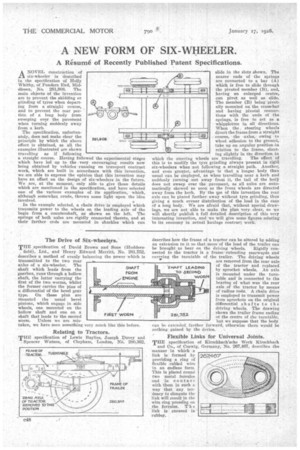A NEW FORM OF SIX-WHEELER.
Page 70

If you've noticed an error in this article please click here to report it so we can fix it.
A Resume of Recently Published Patent Specifications.
ANOVEL construction of six-wheeler is described in the specification of Holly Whitby, of Ponders End, Middlesex, No. 281,908. The main objects of the invention are to prevent the skidding or grinding of tyres when departing from a straight course, and to prevent the rear portion of a long body from sweeping over the pavement when tnrning suddenly away from a kerb.
The specification, unfortunately, does not make clear the principle by which the above effect is obtained, as all the examples illustrated are shown thaveiling as if following a straight course. Having followed the experimental stages Which have led up to the very encouraging results now being obtained by vehicles running on transport contract work, which are built in accordance with this invention, we are able to express the opinion that this invention may have an effect on the design of six-wheelers in the future. We Are, at the moment, only able • to give those details which are mentioned in the specification, and have selected one of the various examples of its application, which, although somewhat crude, throws some light upon the idea involved.
In the example selected, a chain drive is employed which transmits power to the wheels on the leading axle of the bogie from a countershaft, as shown on the left. The springs of both axles are rigidly connected thereto, and at their farther ends are mounted in shackles which can
.2131,Soa
slide in the slots shown. The nearer ends of the springs 411■ ■
111111
_ are connected to a 'bar (A) which is free to slide through the pivoted member (B), and, having an enlarged centre, can pivot as well as slide. The member (B) being -pivdtally mounted on the crowbar and having pivotal connections with the ends of the springs, is free to act as a whippletree in all direction's. When the steering wheels divert the frame from A straight
• course, the •axles, owing to wheel adhesion to the ground, take up an angular position-in relation to the frame, slanting slightly in the direction in
which the steering wheels are travelling. The effect Of this is to modify the tyre grinding always present in rigid six-wheelers when not following a straight path. Another, and even greater, advantage is that a longer body than usual can be employed, as when travelling near a kerb and suddenly turning out away from it, the tail of the body does not sweep over the pavement, as all axles are automatically skewed so soon as the front wheels are directed away from the kerb. By the u,se of this invention the rear axle can he placed farther away without tyre grinding, thus giving a much evener diatribution of the load in the cast: of a long body. We are afraid that, without special drawings, we are not, able to make the plan very clear, so we will shortly publish "a full detailed description of this very interesting invention, and we will give some figures relating "to its economy in actual haulage contract work.












































































































